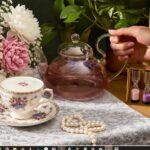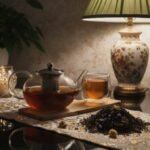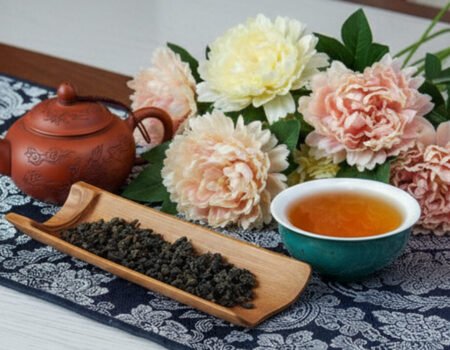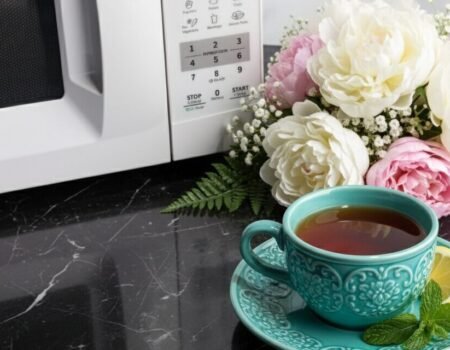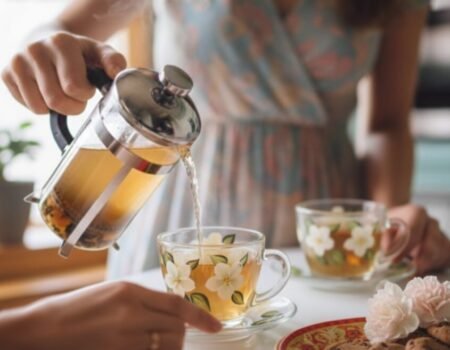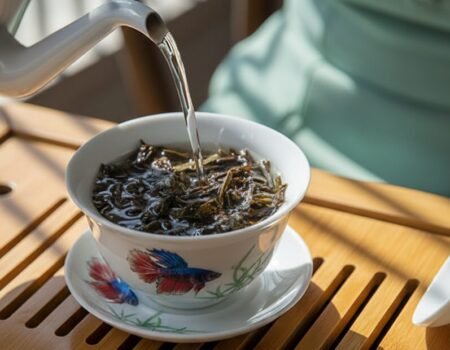
How to Brew Chinese Tea: A Comprehensive Brewing Guide
Index
Index
Chinese tea culture dates back over 1000 years, with each brewing method carefully developed to bring out specific flavors in different tea types. This guide breaks down the essential steps of brewing Chinese tea using traditional Gong Fu Cha methods and other Chinese brewing approaches.
We’ll cover everything from selecting quality leaves to mastering the perfect steep time for green, oolong, pu-erh, and white teas. The right technique makes all the difference.
Key Takeaways
- Different Chinese teas need specific water temperatures – green tea brews best at 167-176°F (75-80°C), while pu-erh requires 203-212°F (95-100°C).
- The Gong Fu Cha method uses more tea leaves with shorter steeping times, typically starting with just 10-15 seconds for the first infusion.
- Quality teaware matters – Yixing clay teapots enhance flavor through their mineral content, while glass teapots let you watch leaves unfurl.
- Most Chinese teas yield 6-10 good infusions when brewed properly using Gongfu style, with oolong and pu-erh often providing 8-15 infusions as each steep reveals different flavor notes.
- Proper measurement for Gongfu style brewing: Green/White tea uses 2g per 100ml, Oolong uses 5g per 100ml, and Pu-erh uses 5-6g per 100ml of water.
Types of Chinese Tea

Chinese tea comes in many forms, each with unique flavors and brewing needs. These teas range from light and grassy to rich and earthy, offering something for every taste preference.
Green Tea
Green tea stands as the oldest form of tea in Chinese culture, dating back thousands of years. Three notable varieties capture the essence of this timeless beverage: Long Jing, Bi Luo Chun, and Mao Jian.
Long Jing features flat leaves that brew into a cup with sweet-pea flavors and roasted chestnut aromas. Bi Luo Chun presents rolled leaves producing a creamy, nutty scent with vegetal tastes.
Mao Jian tea shows twisted leaves that create a vibrant green brew with a sweet finish.
For the best results, brew green tea at 167-176°F (75-80°C). Gongfu style uses 10-30 seconds for the first steep, with delicate varieties like Pi Lo Chun needing 10-15 seconds at the shorter end of this range. This temperature helps extract the delicate flavors without releasing bitter compounds.
The first brew often reveals bright, fresh notes while later infusions may highlight deeper, more subtle tastes. Many tea lovers use a glass teapot to watch the leaves unfurl during the brewing process.
Oolong Tea

Oolong tea stands as a fascinating middle ground in the tea world. This semi-fermented variety bridges the gap between green and black tea flavors, with oxidation levels ranging from 10% to 70%.
Each cup delivers about 30-55 mg of caffeine, making it a moderate energy booster for your day. Tea experts identify high-quality oolong by its distinctive appearance – green leaves with reddish edges signal proper processing.
For the best flavor extraction, brew lighter oolongs at 185-194°F (85-90°C) while darker, more oxidized oolongs use 203-212°F (95-100°C). Gongfu style steeps for 15-30 seconds initially, adding 5-10 seconds for each subsequent infusion.
Proper measurement matters greatly for brewing this traditional Chinese tea. Use 5 grams of loose leaf oolong for each 100ml vessel, whether you choose a teacup or gaiwan. The gong fu style brewing method works especially well with oolong, allowing you to experience how the flavor changes across multiple steeps.
Many tea drinkers enjoy how oolong’s taste evolves from floral and light in early steeps to deeper, more complex notes in later brews. Next, let’s explore another fascinating variety in the Chinese tea family – Pu’erh Tea.
Pu’erh Tea

While Oolong offers complex flavors through partial oxidation, Pu’erh tea delivers a unique taste through post-fermentation. This distinctive tea originates from Yunnan Province in China and develops rich, earthy notes as it ages.
Tea enthusiasts prize Pu’erh for its deep color and smooth taste that improves over time. The tea comes in loose leaf form or compressed into cakes that require a pointed tea knife to break apart before brewing.
Brewing Pu’erh correctly brings out its best qualities. For the traditional Gong Fu Cha method, use 5-6 grams of tea per 100ml of water at 203-212°F (95-100°C), with 212°F (100°C) being optimal for ripe pu-erh. Raw (sheng) pu-erh can use slightly lower temperatures at 195-205°F (91-96°C). The first steep should last 5-10 seconds after a 4-8 second rinse, then add 5-10 seconds per steep as the leaves open and sweetness develops.
Quality Pu’erh leaves can yield 8-15 infusions, which makes it a great option for hosting guests. Many tea shops now stock this once-rare variety, allowing more people to explore its complex flavor profile.
White Tea

Unlike Pu’erh tea’s bold character, White Tea offers a gentle, delicate profile that many tea lovers treasure. This minimally processed variety ranks among China’s most prized teas, with Silver Needle (Bai Hao Yin Zhen) and White Peony standing as popular choices.
The brewing process demands careful attention to temperature—keep it between 167-176°F (75-80°C) and never exceed 185°F (85°C) to preserve its subtle notes.
For great results, use 2g per 100ml cup in Gongfu style. Start with a 10-20 second steep for your first infusion, with option for 5-10 second flash steeps for very delicate varieties, then add 5-10 seconds to each following brew. Quality white tea rewards patience with multiple infusions, each revealing new flavor layers.
The light, sweet taste makes white tea an ideal choice for both new tea drinkers and seasoned experts. Store your tea properly to maintain its freshness for up to a year.
Essential Teaware for Brewing Chinese Tea
Discover the key tools that make Chinese tea brewing both an art and a principle—from clay teapots that enhance flavor to the versatile gaiwan that tea masters prize for tasting sessions.
Teapots (Yixing Clay or Glass)

Yixing clay teapots stand as the gold standard for brewing Chinese tea. These mineral-rich vessels enhance tea flavor through their unique composition. The best options come from unglazed Purple Clay (Zisha) from Yixing, available in five distinct types: Zi Ni, Zhu Sha, Hong Ni, Duan Ni, and L Ni.
Quality Yixing pots produce a clear ringing sound when tapped gently and feature air permeability that allows tea to breathe. Before buying one, check for a crack-free surface, proper weight, a precisely fitting lid, and a spout that pours smoothly.
Glass teapots offer a different experience for brewing Chinese tea. They let you watch tea leaves unfurl during steeping, making them perfect for green teas and other visually appealing varieties.
Unlike clay pots, glass doesn’t absorb flavors, so you can brew different tea types without worry. Many tea shops sell these clear vessels with built-in strainers for easy leaf separation.
Glass pots work best for lower temperature brews since they don’t retain heat as well as clay. For the full tea ceremony experience, a tea tray helps catch spills while you pour the tea into cups.
Gaiwan

A gaiwan serves as a fundamental tool in Chinese tea brewing, consisting of a lidded bowl that emerged during the Ming Dynasty. The name literally translates to “lidded bowl” in Chinese.
This versatile brewing vessel works perfectly for several tea types including green tea, oolong, and white tea. Made from porcelain, glass, or Yixing clay, the gaiwan traps heat effectively while allowing tea leaves to expand fully.
The lid acts as a natural strainer when pouring, keeping leaves in the vessel while letting the liquid flow into cups.
You must master proper handling techniques to avoid burns since the bowl gets hot during brewing. Hold the saucer with your non-dominant hand, use your thumb and index finger to secure the lid, and support the bottom with your remaining fingers.
This grip creates a small gap for tea to pour while keeping leaves inside. Next, we’ll explore other essential teaware needed for an authentic Chinese tea experience.
Tea Cups, Fairness Pitcher and Strainers
Chinese tea cups serve a special purpose in the brewing process. They typically hold between 20 to 50 ml of tea, making them much smaller than Western teacups. These small vessels allow drinkers to savor the full flavor profile without the tea cooling too quickly.

The size also supports the traditional practice of multiple short steeps during a Chinese tea ceremony.
Strainers and a chahai (fair cup or fairness pitcher) work together as essential tools for proper tea service. The chahai ensures each guest receives tea of equal strength and flavor by collecting the full brew before serving.
Strainers catch loose leaves when pouring, creating a smooth drinking experience. Many tea enthusiasts prefer porcelain strainers for their neutral effect on tea taste, while others choose bamboo or metal options based on the specific tea being brewed.
Preparing for the Brewing Process
Preparing for a perfect cup of Chinese tea starts with selecting the right leaves and water. Fresh spring water or filtered tap water brings out the best flavors, while each tea type needs specific temperatures – green tea thrives at lower temperatures while pu-erh demands near-boiling water.
Selecting Quality Tea Leaves
Quality tea leaves form the foundation of any great Chinese tea experience. Most chinese teas come in five main varieties: Black (also called Red in China), Green, White, Oolong, and Pu-erh.

Smart shoppers ask for samples before buying, as this helps you judge the tea’s true character. A useful trick is to taste the 4th or 5th brew of a tea sample, which reveals its actual quality better than the first cup.
Price often signals quality in the tea world, especially when you buy from knowledgeable sellers who understand proper brewing methods. Good tea shops will brew samples using your preferred method at home.
This step matters because brewing techniques change how tea tastes. Look for leaves that maintain their flavor through multiple steeps – this signals high-quality tea. The tea industry offers both premium and basic options, so learning to spot the difference can help you find the tea with the particular depth and character you seek.
Choosing the Right Water and Temperature
Water quality makes a huge difference in your tea’s final taste. Fresh spring water works best for brewing Chinese tea, while you should avoid water that has been boiled more than three times.
The ideal brewing water should maintain a neutral pH between 6-7 with lower mineral content. Green tea especially suffers from water with high mineral substances, resulting in bitter flavors.
Temperature control plays a crucial role in extracting the perfect flavor from each tea type. For delicate leaves like green tea and silver needle white tea, keep temperatures between 167-176°F (75-80°C), never exceeding 185°F (85°C).
Stronger teas can handle higher heat. You’ll find that adjusting brewing temperatures affects the taste profile dramatically – higher temps pull more flavor compounds from the leaf tea but might create bitterness if not watched carefully.
A simple kitchen thermometer helps track these ranges with precision.
Traditional Gong Fu Cha Brewing Method
The Gong Fu Cha method brings ancient Chinese tea wisdom to your cup through a series of mindful steps. This careful brewing style uses shorter steeps with more tea leaves to create deep flavors that change with each pour.
Warming the Teaware

Preheating your teaware stands as the first crucial step in the Gong Fu Cha brewing method. Pour hot water into your gaiwan or teapot and cups before adding any tea leaves.
This process serves multiple purposes: it enhances the flavor profile of your brew, intensifies the aroma, and deepens the color of your final cup. Many tea masters in China stress this step because warm vessels maintain a steady brewing temperature throughout the steeping process.
Proper warming also sterilizes your cups and strainer while preparing the clay or porcelain to interact properly with the tea. Pour hot water into each piece of teaware, let it sit for about 10 seconds, then discard this water before moving to the next brewing step.
For compressed teas like pu-erh, this warming becomes even more vital as it helps prepare the leaves for proper expansion during steeping. The quality of your tea experience improves dramatically with this simple yet often overlooked technique.
Rinsing the Tea Leaves

Rinsing tea leaves marks a crucial first step in the gong fu cha brewing method. You’ll need to pour hot water over your tea leaves for 5-10 seconds for most teas, 2-3 seconds for delicate green teas, or 4-8 seconds for pu-erh and other compressed varieties, then discard this liquid right away.
This quick bath wakes up the tea by removing dust and small particles while beginning to open the leaves. For pu-erh tea and other compressed varieties, this rinse helps break apart the tight chunks and prepares them for proper brewing.
The liquid from this first pour serves another purpose in Chinese tea culture. Many tea masters use it to warm and rinse the serving cups rather than drinking it. This practice enhances the flavor profile of your brew and creates the proper temperature environment for your tea to shine.
Pour the hot rinse water into each cup, swirl it briefly, then discard before filling them with your first proper infusion of tea.
Multiple Steeps for Flavor Extraction
After rinsing the tea leaves, you’ll discover the magic of multiple steeping. Chinese tea offers more than just a single brew. The gongfu method uses a higher tea-to-water ratio to create rich flavors through several short infusions.
Your first brew should last only 10-20 seconds, depending on the tea type. Each following infusion requires 5-10 seconds more than the previous one.
Most quality teas yield 6-10 good infusions, with oolong and pu-erh often providing 8-15 infusions before the flavor starts to fade. This approach prevents the bitterness that comes from long steeping times. Each infusion reveals different flavor notes as the leaves gradually open.
Green teas might show sweet, grassy notes in early infusions, while pu’erh teas develop deeper, earthy flavors in later rounds. The process lets you taste how the tea transforms with each pour.

Brewing Guidelines for Different Tea Types
Each type of Chinese tea needs its own brewing method to bring out the best flavors. Green tea tastes best with cooler water and short steeps, while darker teas like Pu’erh need hotter water and longer brewing times.
Temperature and Brewing Time for Green Tea
Green tea requires precise brewing to release its delicate flavors without extracting bitter compounds. The right temperature and steep time make all the difference between a refreshing cup and a bitter disappointment.
Water that’s too hot will scorch the leaves and create bitter flavors. Most green teas perform best with water between 167-176°F (75-80°C). This temperature range preserves the tea’s natural sweetness and grassy notes.
Different varieties demand specific brewing times in Gongfu style. Pi Lo Chun from Dongting Mountains needs 10-15 seconds for its first steep. Green Tip Tea also requires just 10 seconds initially.
Multiple infusions bring out varying flavor profiles. Second steeps typically need 5-10 seconds longer to extract remaining compounds.
Proper leaf measurement affects flavor intensity. Use about 2 grams of tea leaves for every 100ml of water for balanced results. Too many leaves can make your tea bitter while too few will create a weak brew.
Techniques for Oolong Tea

Brewing oolong tea requires specific techniques based on its fermentation level. For light to moderate fermented oolongs like Anxi Tie Guan Yin and Taiwan Oolong, use water at 185-194°F (85-90°C) while darker, more oxidized oolongs like Wuyi Big Red Robe use 203-212°F (95-100°C) with short Gong Fu style steeps of 15-30 seconds.
You’ll need enough tea leaves to cover the bottom of your teapot or gaiwan. Measure about 5 grams for a 100ml vessel, 12.5 grams for 250ml, and 25 grams for 500ml to achieve proper flavor balance.
Gongfu style works best for oolongs, especially deep fermented varieties like Wuyi Big Red Robe. This method uses shorter steeping times with multiple infusions to extract different flavor layers from the leaves.
Each steep reveals new taste dimensions, making the tea experience more complex and rewarding. The first brew awakens the leaves, while subsequent steeps develop richer flavors and aromas that showcase the tea’s unique character.
Methods for Pu’erh Tea
Pu’erh tea demands specific brewing methods to unlock its rich flavors. For traditional Gong Fu Cha brewing, use 5-6g of tea per 100ml of water. Ripe (shou) pu-erh performs best at 212°F (100°C), while raw (sheng) pu-erh can use slightly lower temperatures at 195-205°F (91-96°C). After rinsing leaves briefly for 4-8 seconds, steep 5-10 seconds initially, increasing by 5-10 seconds in following infusions. Break Pu’erh cakes carefully with a pointed tea knife before brewing.
This approach yields 8-15 infusions, with each steep revealing new taste layers from earthy to mellow sweet as the compressed leaves gradually open.
Tea lovers can also try the simpler Grandpa Style brewing for Pu’erh, which uses less tea and longer steeping times in a larger vessel. Proper storage plays a vital role in maintaining Pu’erh quality – keep your tea away from light, moisture, and strong odors to preserve its character.
Advanced brewing techniques help extract the full potential from this complex tea type.
Advanced Brewing Techniques
Advanced brewing methods like steep time control and aroma layering take your tea skills to the next level – discover these expert techniques to transform your daily cup into a sensory journey.
Adjusting Steep Times for Flavor

Tea brewing becomes an art form once you master steep time adjustments. Each tea type responds differently to timing changes – green tea flavors transform dramatically between short 10-30 seconds Gongfu steeps and longer infusions, shifting from delicate and fresh to more vegetal or bitter notes.
You’ll notice that longer steeps create stronger, sometimes bitter notes, while shorter infusions highlight delicate floral or grassy tones. Pu’erh tea needs 5-10 seconds to release its earthy depth, and white tea benefits from 10-20 seconds for first steep in Gongfu style, with option for 5-10 second flash steeps for very delicate varieties to fully develop its subtle character.
Your brewing temperature plays a crucial role in how quickly flavors extract from leaves. Experiment with your favorite teas by adding or subtracting 5-10 seconds from the standard brew time.
The flavor profile transforms with each adjustment – a 10 second steep might produce light, refreshing notes while 30 seconds brings out rich, complex undertones. Many tea enthusiasts keep brewing journals to track these subtle changes and find their perfect cup.
This practice helps you discover the exact moment when your Chinese tea or Longjing tea reaches its peak flavor.
Layering Aromas in the Tea
Layering aromas transforms a simple cup into a rich sensory journey. This technique involves careful timing between steeps to build complex flavor profiles. You can create depth by starting with a short first steep of 10-15 seconds, then adding 5-10 seconds for each following brew.
The initial steep releases delicate floral notes, while later infusions unlock deeper, more robust flavors. Many tea experts use this method with oolong and pu’erh teas to maximize their flavor potential.
The aroma layering process works best with high-quality leaves that support multiple brews without losing taste. Try pouring tea from different heights to introduce oxygen that enhances fragrance.
A gaiwan or Yixing teapot helps capture these layered scents effectively. The Chinese method focuses on this gradual flavor extraction rather than brewing everything at once. Master this skill, and you’ll discover nuances in your tea that remain hidden with standard brewing approaches.

Tips for an Authentic Tea Experience
Savoring tea is a subtle art beyond just drinking it – it starts by noticing the aroma changes between multiple steeps to storing your tea leaves properly for maximum freshness to how these small details create a more rewarding experience with your next cup.
Appreciating the Fragrance
Tea fragrance offers the first glimpse into your brew’s character. Quality Chinese teas release distinct aromas that change with each steep. Take a moment to lift your cup close to your nose before sipping.
The scent of green tea might reveal grassy notes, while oolong presents fruity or floral hints. Purple Clay teapots enhance these natural fragrances by trapping and concentrating the volatile compounds.
Your tea experience improves greatly through aroma focus. Try this simple exercise: brew the same tea leaves multiple times and notice how the fragrance shifts. The first steep might deliver bold, sharp scents while later brews reveal subtle, sweet undertones.
This practice trains your senses to detect nuance in different tea types. Many tea shops in China place special cups called “aroma cups” alongside drinking vessels specifically for this sensory appreciation.
Maintaining the Quality of Tea Leaves
Beyond enjoying tea’s aroma, proper storage extends your tea’s life and flavor. Store tea leaves in airtight containers away from light, heat, and strong odors. Glass jars or metal tins work best for keeping tea fresh for about a year.

Place these containers in a cool, dry cabinet rather than near your stove or sunny windows.
Quality tea deserves careful handling to preserve its bright appearance and rich taste. Avoid using wet spoons to scoop dry leaves, as moisture speeds up spoilage. High-grade teas can yield 6-10 flavorful brews when stored correctly.
Many Chinese tea shops recommend ceramic containers with tight-fitting lids for pu’erh tea, while vacuum flasks help green tea maintain its delicate qualities longer.
Conclusion
Brewing Chinese tea connects you to a rich tradition that spans thousands of years. With the right tools, water temperature, and timing, you can unlock deep flavors from even simple leaves.
Each tea type offers unique tastes waiting to be discovered through patient practice. Your tea journey will grow more rewarding as you master the basics and move toward advanced Gongfu techniques.
Start with quality leaves, respect the brewing process, and soon you’ll create perfect cups that bring both joy and calm to your daily life.
FAQs
1. How much tea should I use when brewing Chinese tea?
The amount of tea depends on the type you’re brewing in Gongfu style: Green and White tea use 2g per 100ml, Oolong uses 5g per 100ml, and Pu-erh uses 5-6g per 100ml. You can adjust based on how strong you prefer your tea.
2. What’s the best water temperature for brewing Chinese tea?
Different teas need different water temperatures. Green teas need 167-176°F (75-80°C). Light oolongs use 185-194°F (85-90°C) while darker oolongs use 203-212°F (95-100°C). Pu-erh needs 203-212°F (95-100°C), with ripe pu-erh best at 212°F (100°C).
3. Should I rinse the tea leaves before brewing?
Yes, rinsing helps wake up the tea leaves and removes dust. Pour hot water over the leaves and discard after 5-10 seconds for most teas, 2-3 seconds for delicate greens, or 4-8 seconds for pu-erh and compressed varieties.
4. What is Gongfu tea brewing?
Gongfu tea is a traditional Chinese method for brewing high quality tea. It uses a measured amount of tea with less water and shorter steep times. This method brings out the best cup with rich flavors, and you can brew the same leaves multiple times.
5. How long should I let the tea steep?
Steeping time varies by tea type in Gongfu style: Green teas need 10-30 seconds, oolong teas need 15-30 seconds, and Pu-erh tea after a quick rinse usually needs 5-10 seconds. Add 5-10 seconds for each additional steep.
6. Can I make multiple brews from the same tea leaves?
Absolutely! Fine Chinese teas are meant for multiple brews. After your first cup, just add more hot water to the same leaves. Each brew will have a different flavor profile, with many teas improving on the second or third brew. Quality teas yield 6-10 infusions, with oolong and pu-erh often providing 8-15.
References
- https://inpursuitoftea.com/blogs/the-ipot-journal/chinese-green-tea (2025-04-11)
- https://www.rupahealth.com/post/oolong-tea-a-complete-guide-to-types-benefits-and-brewing
- https://www.heychina.com.au/b/how-to-make-chinese-tea-brewing-guide/?srsltid=AfmBOorWrZwLYsTSiWbL0_JQh-Jkc0rCDQU-oAJFhcsMffJRaKg7rpjW (2019-11-17)
- https://pressbooks.cuny.edu/chinesefarmerteas/chapter/how-to-brew-and-enjoy-chinese-white-tea/
- https://pathofcha.com/blogs/all-about-tea/a-comprehensive-guide-on-choosing-yixing-clay-teapot?srsltid=AfmBOoooaA8QogkrDdXT-CJRO1qJiB2I-kFNIaFlyhM5qDLCA_cq_2j2
- https://sevencups.com/learn-about-tea/brewing-tea/making-yixing-teaware/?srsltid=AfmBOopa4-B-rnLaNtXLOL6ac9wjL7GurtIEayDlxXGPh_PDj0mAQkO2
- https://www.paperandtea.com/blogs/journal/gaiwan-tea-preparation (2024-12-31)
- https://chazhidao.org/en/second-circle/tea-ware-chinese-brewing-choice
- https://thechineseteashop.com/pages/gong-fu-cha-the-complete-guide-to-making-chinese-tea
- https://pmc.ncbi.nlm.nih.gov/articles/PMC10192933/
- https://teajewel.com/blogs/news/how-to-brew-chinese-tea-gong-fu-cha-a-step-by-step-guide
- https://www.teasenz.com/chinese-tea/gongfu-tea-ceremony.html
- https://guide.michelin.com/en/article/people/ask-the-expert-a-beginner-s-guide-to-chinese-gong-fu-tea
- https://inpursuitoftea.com/blogs/the-ipot-journal/gong-fu-tea-ceremony (2024-07-26)
- https://www.theoolongdrunk.com/single-post/a-beginners-guide-how-to-make-gong-fu-tea
- https://www.heychina.com.au/b/how-to-make-chinese-tea-brewing-guide/?srsltid=AfmBOoqcX9_JQ3dyi_h_6oLrRYQu4gS7CuVBjljg2j5kee8x86AWksQH
- https://www.heychina.com.au/b/how-to-make-chinese-tea-brewing-guide/?srsltid=AfmBOopcoCMbx9rme8JDqVgN3H66FMv0QoSashcKbqwMSxXLyxAL493- (2019-11-17)
- https://satotea.com/blogs/wild-farmed-tea-blog/tea-brewing-guide-how-to-brew-oolong-tea-a-primer?srsltid=AfmBOor4IzfLM6K-StQkrtcXXNZ8Za6CRW5JhQzsAu9mOA92sJ0JhJQD (2024-01-28)
- https://frasertea.com/blogs/traditions/how-to-brew-pu-erh-tea?srsltid=AfmBOop6oKGL-55wGH1JzSN5T6AhfJGNXsJE9ar2StlRmr968-tCB4BA
- https://www.heychina.com.au/b/how-to-make-chinese-tea-brewing-guide/?srsltid=AfmBOoq6E0p4xpHQaF3JWlfim9r7GJPriPjnERc4-sDbWhyyFae5E00Q
- https://teatsy.com/blogs/blog/how-to-brew-chinese-tea?srsltid=AfmBOoq4dquK_ey7RGUhjvY5gQpFELltpWr-pwpQpaal-N7RPqo9pZJq

